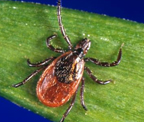Health officials are reminding the public that with the official start of summer coming soon, so does need to be aware of tick-related incidents when enjoying outdoor activities, especially for children.
According to the Illinois Department of Public Health, the most common type of ticks that spread disease to animals and humans in Illinois are deer or (black-legged) ticks.
Manasi Hulyalkar, a pediatrician with HSHS Medical Group Multi-specialty Care in Jacksonville says she encourages children to enjoy outdoor activities, but just like taking precaution with sunscreen, parents need to be vigilant about protecting them from disease-carrying ticks.
“During any kind of outdoor activities, essentially you should keep an eye out for ticks, and secondly you should know what they look like. They are small organisms that can be brownish to reddish in appearance. In Illinois we see something called a deer tick, it’s pretty small and reddish to dark brown in color. If you see anything like that on the skin and you’re concerned we’d be happy to take a look at it.”
Deer ticks are a known carrier of Lyme Disease, which can cause illness within 3 to sometimes as much as 30 days after being exposed to a deer tick.
Hulyalkar says both parents and adults who spend time outdoors need to be aware of the signs of a tick bite.
“There would be redness at the bite site and something that is called target legions. So there is a small spot in the middle which is surrounded by a reddish circle, and that is the very classic legion for tick bites. But it can also present itself in different forms of rashes as well. If you see any kind of rash and you suspect it is from a bite, you should keep in the back of your mind that it could be a tick bite.”
Symptoms from tick bites can be similar to flu like symptoms including headaches, fever and muscle aches. Hulyalkar says if you are having these kinds of symptoms, or suspect a rash or skin abnormality might be from a tick, you should call your primary physician.
She says if you find a tick on your skin, remove it carefully, but also as quickly as possible.
“Especially with younger ones, as soon as kids come in from playing, it’s a good idea to check them all over to see if they have any bites or anything stuck on their skin. Look especially in their hair and under their arms where ticks could be hiding.
If you actually notice a tick on the skin, the recommendations from the C.D.C. are to take tweezers and try to grab the insect in one go and pull it out straight from the skin.”
Hulyalkar says try to grab the tick starting as close to the skin as possible, to avoid squeezing or crushing the body of the tick. This can cause the tick to inject it’s body fluids increasing the risk of infection. And after removing the tick, wash hands well with soap and water.
She says a common misconception with removing ticks is, if any part of the mouth of the tick remains in the skin after removal to try and pull it out as well. She says it’s recommended to leave it alone and it will come out on its own. Attempting to remove these parts may result in skin trauma and increase your risk of infection not associated with Lyme disease.
She says if you or your children will be spending time outdoors, especially in wooded areas, wearing light colored clothing and using insect repellents containing at least 20% DEET can greatly reduce the risk of tick bites.




